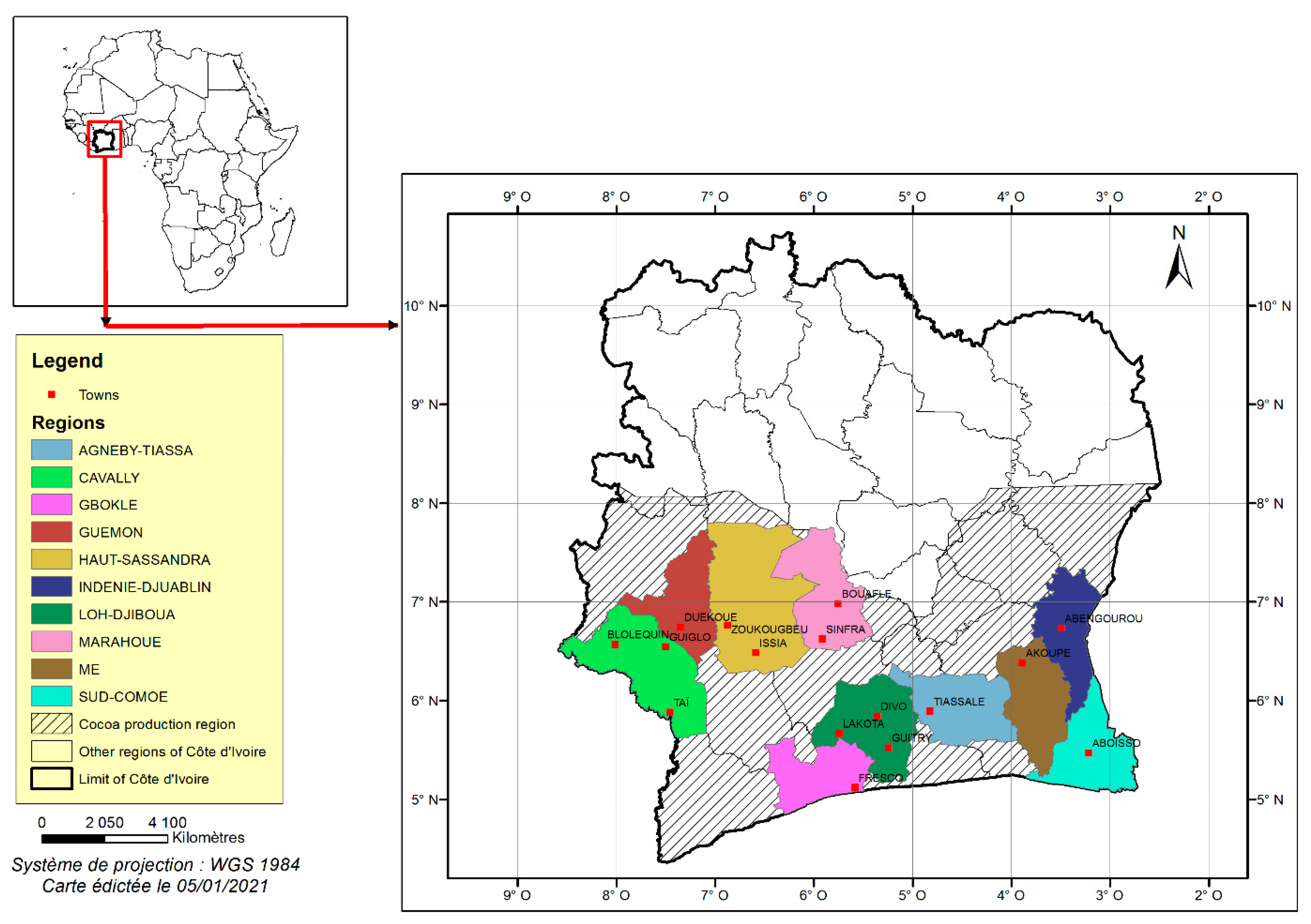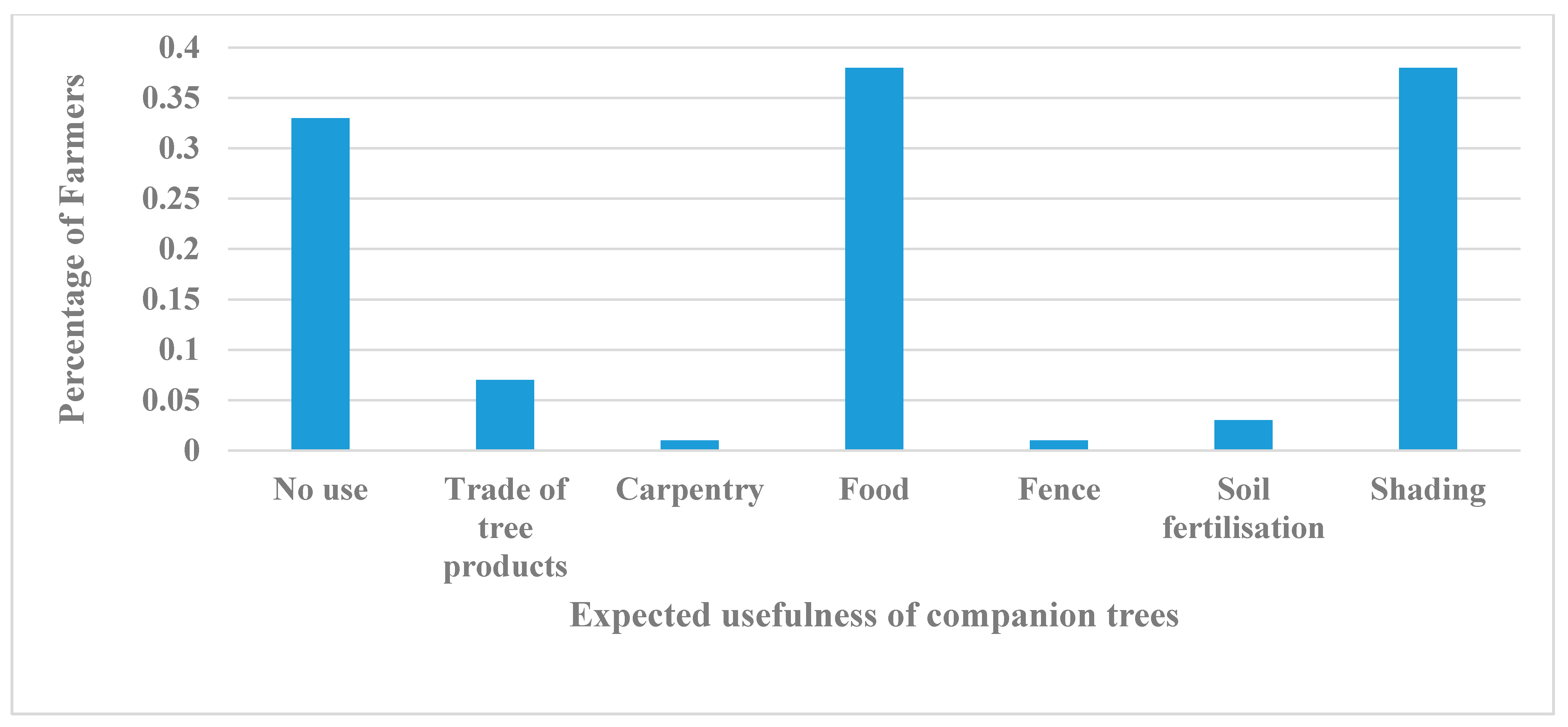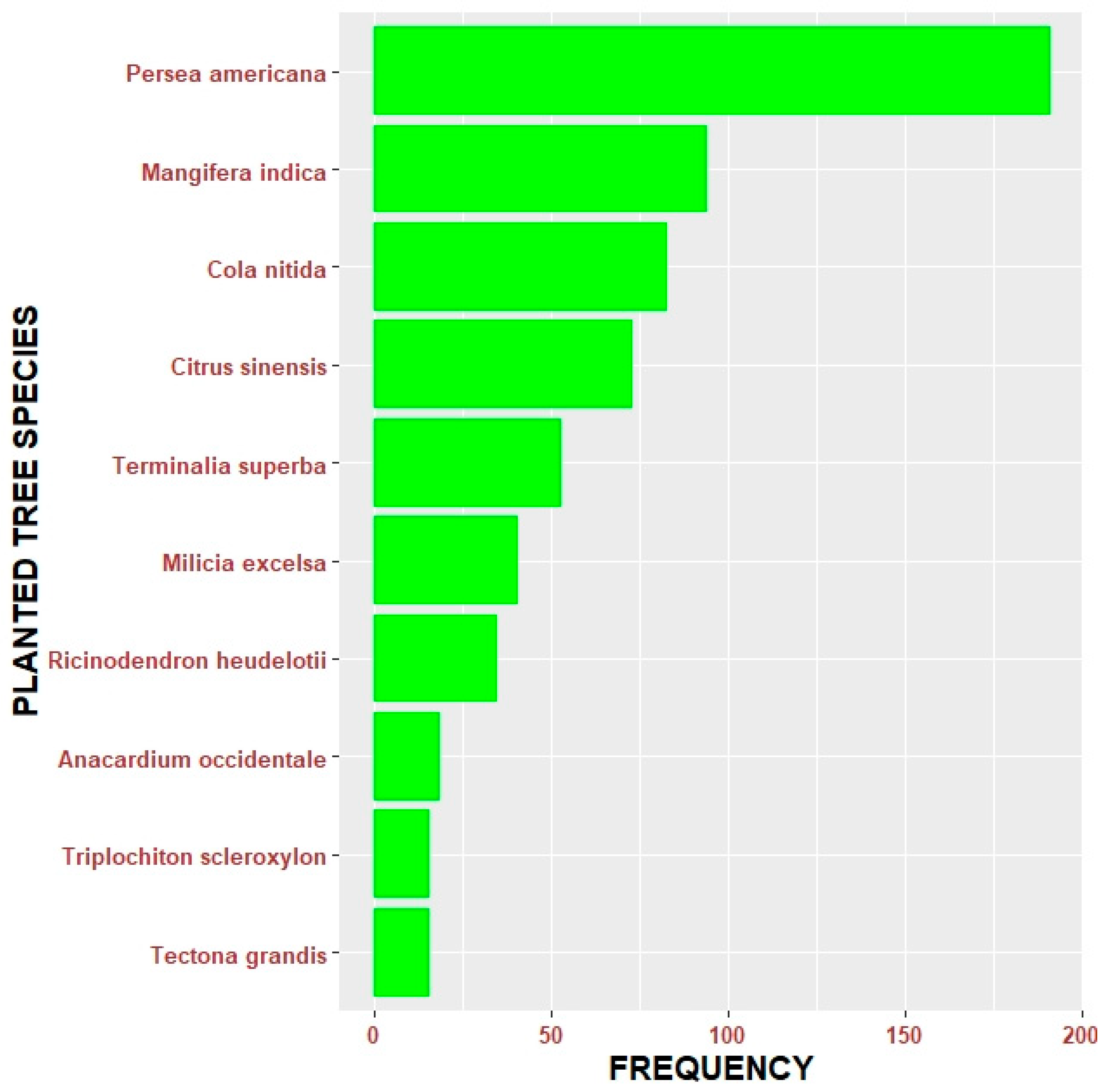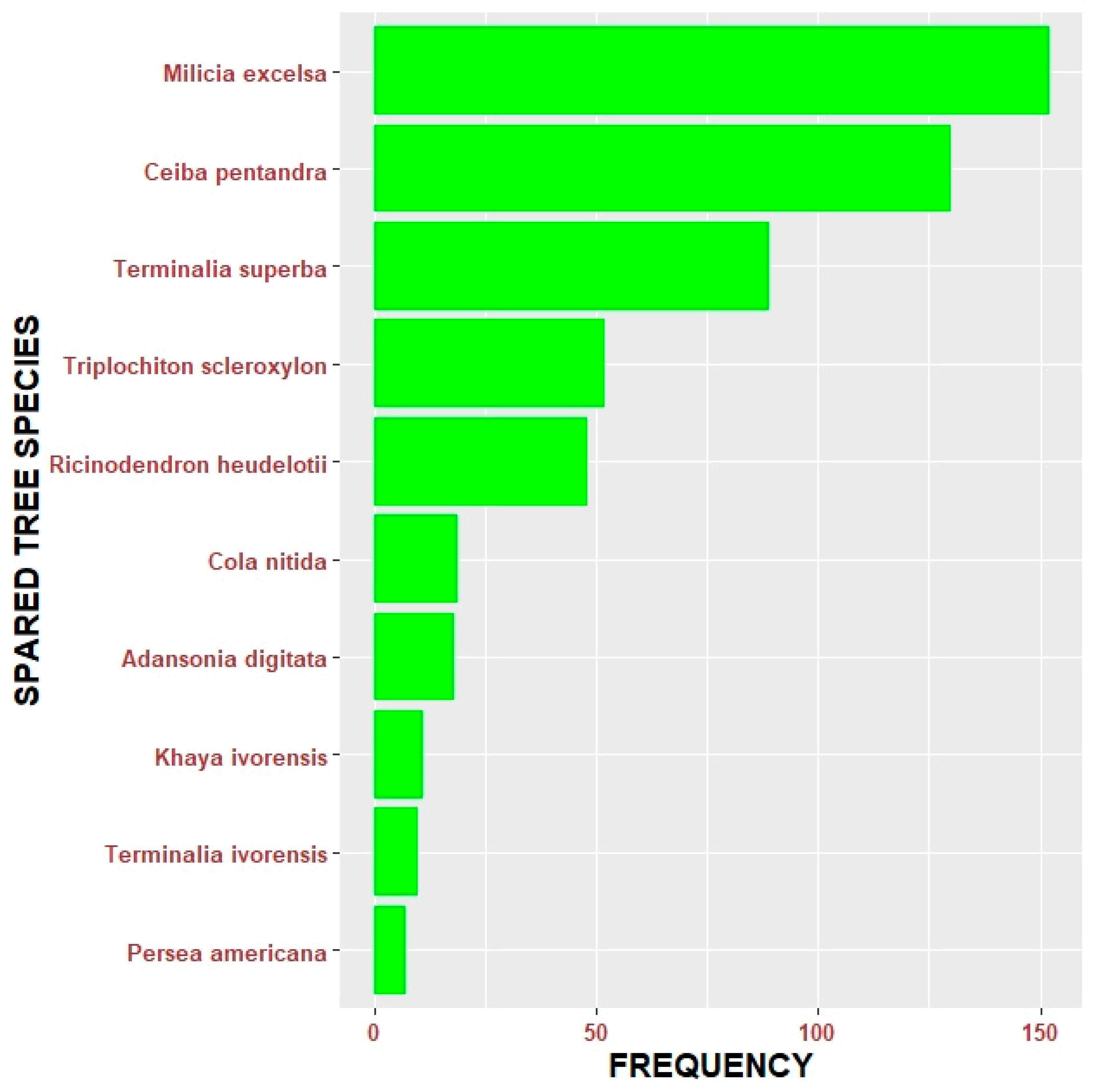Rebuilding Tree Cover in Deforested Cocoa Landscapes in Côte d’Ivoire: Factors Affecting the Choice of Species Planted
Abstract
1. Introduction
2. Materials and Methods
2.1. Sites of Study
2.2. Sampling
2.3. Description of the Questionnaire
2.4. Data Collection and Analysis
3. Results
3.1. Tree Species Planting
3.2. Tree Species Retained on Land Cleared for Cocoa Farming
4. Discussion
5. Conclusions
Author Contributions
Funding
Informed Consent Statement
Data Availability Statement
Acknowledgments
Conflicts of Interest
References
- ICCO. Quarterly Bulletin of Cocoa Statistics; Cocoa Year 2019/20: London, UK, 2020; Volume XLVI, No.2. [Google Scholar]
- Asomaning, E.J.A.; Kwakwa, R.S.; Hutcheon, W.V. Physiological studies on an Amazon shade and fertilizer trial at the Cocoa Research Institute of Ghana. Ghanaian J. Agric. Sci. 1971, 4, 47–64. [Google Scholar]
- Ahenkorah, Y.; Akrofi, G.S.; Adri, A.K. The end of the first cocoa shade and manurial experiment at the Cocoa Research Institute of Ghana. J. Hortic. Sci. 1974, 49, 43–51. [Google Scholar] [CrossRef]
- Koné, M.; Kouadio, Y.L.; Neuba, D.F.R.; Malan, D.F.; Coulibaly, L. Evolution de la couverture forestière de la Côte d’Ivoire des années 1960 au début du 21ème siècle. Int. J. Innov. Appl. Stud. 2014, 7, 782–794. [Google Scholar]
- African Union Development Agency. Available online: https://afr100.org/content/cote-divoire (accessed on 2 November 2020).
- Leakey, R.R.B.; Tchoundjeu, Z. Diversification of tree crops: Domestication of companion crops for poverty reduction and environmental services. Exp. Agric. 2001, 37, 279–296. [Google Scholar] [CrossRef]
- Leakey, R.R.B. From ethnobotany to mainstream agriculture: Socially modified Cinderella species capturing ‘trade-ons’ for ‘land maxing’. Planta 2019, 250, 949–970. [Google Scholar] [CrossRef]
- Leakey, R.R.B. A holistic approach to sustainable agriculture: Trees, science and global society. In Agroforestry for Sustainable Agriculture; Mosquera-Losada, M.R., Prabhu, R., Eds.; Burleigh Dodds Science Publishing: Cambridge, UK, 2019. [Google Scholar] [CrossRef]
- Leakey, R.R.B. A re-boot of tropical agriculture benefits food production, rural economies, health, social justice and the environment. Nat. Food 2020, 1, 260–265. [Google Scholar] [CrossRef]
- Holl, K.D.; Brancalion, P.H.S. Tree planting is not a simple solution. Science 2020, 368, 580–581. [Google Scholar] [CrossRef]
- Khasa, D.; Atangana, A. Tropical tree domestication in agroforestry. In Agroforestry for Sustainable Agriculture; Mosquera-Losada, M.R., Prabhu, R., Eds.; Burleigh Dodds Science Publishing: Cambridge, UK, 2019. [Google Scholar] [CrossRef]
- Franzel, S.; Jaenicke, H.; Janssen, W. Choosing the Right Trees: Setting Priorities for Multipurpose Tree Improvement; Research Report No 8; ISNAR: The Hague, The Netherlands, 1996; p. 87. [Google Scholar]
- Maghembe, J.; Simons, A.J.; Kwesiga, F.; Rarieya, M. Selecting Indigenous Trees for Domestication in Southern Africa; ICRAF: Nairobi, Kenya, 1998; p. 94. [Google Scholar]
- Lebot, V.; Walter, A.; Sam, C. The domestication of fruit and nut tree species in Vanuatu, Oceania. In Indigenous Fruit Tree in the Tropics: Domestication, Utilization and Commercialization; Akinnifesi, F.K., Leakey, R.R.B., Ajayi, O., Eds.; CABI: Wallingford, UK, 2008; pp. 120–136. [Google Scholar]
- Pauku, R.L.; Lowe, A.J.; Leakey, R.R.B. Domestication of indigenous fruit and nut trees for agroforestry in the Solomon Islands. For. Trees Livelihoods 2010, 19, 269–287. [Google Scholar] [CrossRef]
- Roshetko, J.; Verbist, B. Tree Domestication; ICRAF-SE Asia Lecture No 6: Nairobi, Kenya, 2000; p. 12. [Google Scholar]
- Sotelo Montes, C.; Weber, J.C. Priorizacio’n de especies arboreas para sistemas agroforestales en la selva baja del Peru. Agrofor. Am. 1997, 4, 12–17. [Google Scholar]
- Leakey, R.R.B. Converting ‘trade-offs’ to ‘trade-ons’ for greatly enhanced food security in Africa: Multiple environmental, economic and social benefits from ‘socially modified crops’. Food Secur. 2018, 10, 505–524. [Google Scholar] [CrossRef]
- Leakey, R.R.B.; Tchoundjeu, Z.; Smith, R.I.; Munro, R.C.; Fondoun, J.M.; Kengue, J.; Anegbeh, P.O.; Atangana, A.R.; Waruhiu, A.N.; Asaah, E.; et al. Evidence that subsistence farmers have domesticated indigenous fruits (Dacryodes edulis and Irvingia gabonensis) in Cameroon and Nigeria. Agrofor. Syst. 2004, 60, 101–111. [Google Scholar] [CrossRef]
- Gyau, A.; Smoot, K.; Diby, L.; Kouamé, C. Drivers of tree presence and density: The case of cocoa agroforestry systems in the Soubré Region in the Republic of Cote d’Ivoire. Agrofor. Syst. 2015, 89, 149–161. [Google Scholar] [CrossRef]
- Kaba, J.S.; Otuh-Nyanteh, A.; Abunyemah, A.A. The role of shade trees in influencing farmers’ adoption of cocoa agroforestry systems: Insight from semi-deciduous rain forest agroecological zone of Ghana. NJAS Wagening. J. Life Sci. 2020, 92, 100332. [Google Scholar] [CrossRef]
- Leakey, R.R.B. Agroforestry Participatory domestication of trees. In Encyclopedia of Agriculture and Food Systems; Van Alfen, N., Ed.; Elsevier Publishers: San Diego, CA, USA, 2014; Volume 1, pp. 253–269. [Google Scholar]
- Conseil Café-Cacao de Côte d’Ivoire. Note À L’attention des Acteurs de la Filière Café-Cacao (No de Référence 019/2019); Conseil du Cafe-Cacao: Abidjan, Cote d’Ivoire, 2019. [Google Scholar]
- Pattanayak, S.K.; Mercer, D.E.; Sills, E.; Yang, J.C. Taking stock of agroforestry adoption studies. Agrofor. Syst. 2003, 57, 173–186. [Google Scholar] [CrossRef]
- Degrande, A.; Asaah, E.; Tchoundjeu, Z.; Kanmegne, J.; Duguma, B.; Franzel, S. Opportunities for and constraints to adoption of improved fallows: ICRAF’s experience in the humid tropics of Cameroon. In Advances in Integrated Soil Fertility Management in Sub-Saharan Africa: Challenges and Opportunities; Bationo, A., Waswa, B., Kihara, J., Kimetu, J., Eds.; Springer: Dordrecht, The Netherlands, 2007; pp. 901–910. [Google Scholar]
- Meijer, S.S.; Catacutan, D.; Ajayi, O.C.; Sileshi, G.W.; Nieuwenhuis, M. The role of knowledges, attitudes and perceptions in the uptake of agricultural and agroforestry innovations among smallholder farmers in sub-Saharan Africa. Int. J. Agric. Sustain. 2015, 13, 40–54. [Google Scholar] [CrossRef]
- Dhakal, A.; Cockfield, G.; Maraseni, T.M. Deriving an index of adoption rate and assessing factors affecting adoption of an agroforestry-based farming system in Dhanusha District, Nepal. Agrofor. Syst. 2015, 89, 645–661. [Google Scholar] [CrossRef]
- Etshekape, P.G.; Atangana, A.R.; Khasa, D.P. Tree planting in urban and peri-urban of Kinshasa: Survey of factors facilitating agroforestry adoption. Urban For. Urban Green. 2018, 30, 12–23. [Google Scholar] [CrossRef]
- Dhakal, A.; Kumar Rai, R. Who adopts agroforestry in a subsistence economy? Lessons from the Terai of Nepal. Forests 2020, 11, 565. [Google Scholar] [CrossRef]
- Glover, E.K.; Ahmed, H.B.; Glover, M.K. Analysis of socio-economic conditions influencing adoption of agroforestry practices. Int. J. Agric. For. 2013, 3, 178–184. [Google Scholar] [CrossRef]
- Sanou, L.; Savadogo, P.; Ezebilo, E.E.; Thiombiano, A. Drivers of farmers’ decision to adopt agroforestry: Evidence from the Sudanian savanna zone, Burkina Faso. Renew. Agric. Food Syst. 2017, 34, 116–133. [Google Scholar] [CrossRef]
- Beyene, A.D.; Mekonnen, A.; Randall, B.; Deribe, R. Household levels determinants of agroforestry practices adoption in rural Ethiopia. For. Trees Livelihoods 2019, 28, 194–213. [Google Scholar] [CrossRef]
- Degrande, A.; Schreckenberg, K.; Mbosso, C.; Anegbeh, P.; Okafor, V.; Kanmegne, J. Farmers’ fruit tree-growing strategies in the humid forest zone of Cameroon and Nigeria. Agrofor. Syst. 2006, 67, 159–175. [Google Scholar] [CrossRef]
- Herzog, F. Multipurpose shade trees in coffee and cocoa plantations in Côte d’Ivoire. Agrofor. Syst. 1994, 27, 259–267. [Google Scholar] [CrossRef]
- Benveniste, C. La Boucle du Cacao en Côte d’Ivoire, Etude Régionale des Circuits de Transport; travaux et Documents de l’ORSTOM n° 31; ORSTOM: Paris, France, 1974; p. 216.
- Linder, H.P. Plant diversity and endemism in sub-Saharan tropical Africa. J. Biogeogr. 2001, 28, 169–182. [Google Scholar] [CrossRef]
- Beentje, H.K.; Adams, B.; Davis, S.D.; Hamilton, A.C. Regional overview: Africa. In Centres of Plant Diversity; Davis, S.D., Heywood, V.H., Hamilton, A.C., Eds.; IUCN Publication Unit: Cambridge, UK, 1994; pp. 101–148. [Google Scholar]
- Sosef, M.S.M.; Dauby, G.; Blach-Overgaard, A.; Van Der Burgt, X.; Catarino, L.; Damen, T.; Deblauwe, V.; Dessein, S.; Couvreur, T.L.P. Exploring the floristic diversity of tropical Africa. BMC Biol. 2017, 15, 15. [Google Scholar] [CrossRef]
- Santos, P.Z.F.; Crouzeilles, R.; Sansevero, J.B.B. Can agroforestry systems enhance biodiversity and ecosystem service provision in agricultural landscapes? A meta-analysis for the Brazilian Atlantic forest. For. Ecol. Manag. 2019, 433, 140–145. [Google Scholar] [CrossRef]
- Sonwa, D.J.; Weise, S.F.; Nkongmeneck, B.A.; Tchatat, M.; Janssens, M.J.J. Structure and composition of cocoa agroforests in the humid forest zone of Southern Cameroon. Agrofor. Syst. 2017, 91, 451–470. [Google Scholar] [CrossRef]
- Marsden, C.; Martin-Chave, A.; Cortet, J.; Hedde, M.; Capowiez, Y. How agroforestry systems influence soil fauna and their functions—A review. Plant Soil 2019, 453, 29–44. [Google Scholar] [CrossRef]
- Villanueva-López, G.; Lara-Pérez, L.A.; Oros-Ortega, I.; Ramírez-Barajas, P.J.; Casanova-Lugo, F.; Ramos-Reyes, R.; Aryal, D.B. Diversity of soil macro-arthropods corelates to the richness of plant species in traditional agroforestry systems in the humid tropics of Mexico. Agric. Ecosyst. Environ. 2019, 286, 106658. [Google Scholar] [CrossRef]
- Leakey, R.R.B. The role of trees in agroecology and sustainable agriculture in the tropics. Ann. Rev. Phytopathol. 2014, 52, 113–133. [Google Scholar] [CrossRef]
- Halle, B.; Bruzon, V. Profil Environnemental de la Côte d’Ivoire; Rapport; Commission Européenne: Brussels, Belgium, 2006. [Google Scholar]
- Zinger, A. Estimation de variance avec échantillonnage schématique. Rev. Stat. Appl. 1963, 11, 89–97. [Google Scholar]
- Census and Survey Processing System. Available online: https://www.census.gov/data/software/cspro.html. (accessed on 20 October 2020).
- Consul, P.C.; Famoye, F. Generalized Poisson regression model. Commun. Stat. 1992, 21, 89–109. [Google Scholar] [CrossRef]
- Famoye, F. A multivariate Generalized Poisson regression model. Commun. Stat. Theory Methods 2015, 44, 497–511. [Google Scholar] [CrossRef]
- Smith Dumont, E.; Gnahoua, G.M.; Ohouo, L.; Sinclair, F.L.; Vaast, P. Farmers in Côte d’Ivoire value integrating tree diversity in cocoa for the provision of ecosystem services. Agrofor. Syst. 2014, 88, 1047–1066. [Google Scholar] [CrossRef]
- Anglaaere, L.C.N.; Cobbina, J.; Sinclair, F.L.; McDonald, M.A. The effect of land use system on tree diversity: Farmer preference and species composition of cocoa-based agroecosystems in Ghana. Agrofor. Syst. 2011, 81, 249–265. [Google Scholar] [CrossRef]
- Asigbaase, M.; Sjogersten, S.; Lomax, B.H.; Dawoe, E. Tree diversity and its ecological importance value in organic and conventional cocoa agroforests in Ghana. PLoS ONE 2019, 14, e0210557. [Google Scholar] [CrossRef] [PubMed]
- Kessler, M.; Kebler, P.J.A.; Gradstein, S.R.; Bach, K.; Schmull, M.; Pitopang, R. Tree diversity in primary forest and different land use systems in Central Sulawesi, Indonesia. Biodivers. Conserv. 2005, 14, 547–560. [Google Scholar] [CrossRef]
- Dinh Le, H.; Smith, C.; Herbohn, J. What drives the success of reforestation projects in tropical developing countries? The case of the Philippines. Glob. Environ. Chang. 2014, 24, 334–348. [Google Scholar] [CrossRef]
- Simons, A.J.; Leakey, R.R.B. Tree domestication in tropical agroforestry. In New Vistas in Agroforestry. Advances in Agroforestry; Nair, P.K.R., Rao, M.R., Buck, L.E., Eds.; Springer: Dordrecht, The Netherlands, 2004; Volume 1. [Google Scholar] [CrossRef]
- Takoutsing, B.; Tchoundjeu, Z.; Degrande, A.; Asaah, E.; Tsobeng, A. Scaling-up land management practices through the concept of the rural resource centre; reconciling farmers’ interests with research agendas. J. Agric. Educ. Ext. 2014, 20, 463–483. [Google Scholar] [CrossRef]
- Koko, K.L.; Snoeck, D.; Lekadou, T.T.; Assiri, A.A. Cacao-fruit trees intercropping effects on cocoa yield, plant vigour and light interception in Côte d’Ivoire. Agrofor. Syst. 2013, 87, 1043–1052. [Google Scholar] [CrossRef]
- Rocha, H.M.; Miranda, R.A.C.; Sgrillo, R.B.; Setubal, R.A. Witches’ Broom in Bahia, Brazil. In Disease Management in Cocoa; Rudgard, S.A., Maddison, A.C., Andebrhan, T., Eds.; Springer: Dordrecht, The Netherlands, 1993. [Google Scholar] [CrossRef]
- Alger, K.; Caldas, M. The declining cocoa economy and the Atlantic Forest of Southern Bahia, Brazil: Conservation attitudes of cocoa planters. Environmentalist 1994, 14, 107–119. [Google Scholar] [CrossRef]
- Lojka, B.; Pawera, L.; Kalousová, M.; Bortl, L.; Verner, V.; Houška, J.; Vanhowe, W.; Van Damme, P. Multistrata systems: Potentials and challenges of cocoa-based agroforestry in the tropics. In Agroforestry; Dagar, J.J., Tewari, V., Eds.; Springer: Singapore, 2017. [Google Scholar] [CrossRef]
- Utomo, B.; Prawoto, A.A.; Bonnet, S.; Bangviwat, A.; Gheewala, S.H. Environmental performance of cocoa production from monoculture and agroforestry systems in Indonesia. J. Clean. Prod. 2016, 134, 583–591. [Google Scholar] [CrossRef]
- Wartenberg, A.C.; Blaser, W.J.; Gattinger, A.; Six, J.; Van Noordwijk, M.; Roshetko, J.M. Does shade tree diversity increase soil fertility in cocoa plantations? Agric. Ecosyst. Environ. 2017, 248, 190–199. [Google Scholar] [CrossRef]
- Isbell, F.; Adler, P.R.; Eisenhauer, N.; Fornara, D.; Kimmel, K.; Kremen, C.; Letourneau, D.K.; Liebman, M.; Polley, H.W.; Quijas, S.; et al. Benefits of increasing plant diversity in sustainable agroecosystems. J. Ecol. 2017, 105, 871–879. [Google Scholar] [CrossRef]
- Sauvadet, M.; Saj, S.; Freschet, G.T.; Essobo, J.D.; Enock, S.; Becquer, T.; Tixier, P.; Harmand, J.-M. Cocoa agroforest multifunctionality explained by shade tree litter traits. J. Appl. Ecol. 2020, 57, 476–487. [Google Scholar] [CrossRef]
- Wartenberg, A.C.; Blaser, W.J.; Gattinger, A.; Roshetko, J.M.; Van Noordwijk, M.; Six, J. Soil fertility and Theobroma cacao growth and productivity under commonly intercropped shade-tree species in Sulawesi, Indonesia. Plant Soil 2020, 453, 87–104. [Google Scholar] [CrossRef]
- Agbo, E.; Mahyao, A.; Konan, A.D.; Coulibaly, L.; Kouassi, A.; Kehlenbeck, K.; Kouamé, C. Production, Consumption and Nutrition Survey in a Cocoa Farming Area in the Nawa Region; Report; ICRAF: Abidjan, Côte d’Ivoire, 2014; p. 137. [Google Scholar]
- Agbo, E.; Kouamé, C.; N’Doua, D.; Kouassi, A.; Brou, K. Assessment of Cocoa Producers’ Children Nutritional Status in the Nawa Region, Cote d’Ivoire. J. Food Nutr. Res. 2017, 5, 606–613. [Google Scholar]
- De Vries, K.; Mc Clafferty, B.; Van Dorp, M. Increasing Cocoa Productivity Through Improved Nutrition—A Call to Action, Concept Brief; Global Alliance for Improved Nutrition; Wageningen University: Wageningen, The Netherlands, 2012; p. 24. [Google Scholar]




| Geographical Zone | Region | Number of Surveyed Households |
|---|---|---|
| East | Indénié-Djuablin | 64 |
| Sud-Comé | 152 | |
| Center | Lôh-Djiboua | 89 |
| Marahoué | 56 | |
| South | Mé | 36 |
| Agneby-Tiassalé | 26 | |
| West | Cavally | 98 |
| Gbôklé | 26 | |
| Guémon | 67 | |
| Haut-Sassandra | 69 | |
| Total | 683 |
| Source of Variation | Coefficient | z | p-Value | Incidence Rate Ratio | Confidence Interval |
|---|---|---|---|---|---|
| Sociodemographic characteristics | |||||
| Cocoa sourcing zone | |||||
| East | 0 | 1 | |||
| West | −0.0272 | −0.57 | 0.567 | 0.9731779 | 0.8866995–1.06809 |
| South | −0.219 ** | −2.73 | 0.006 | 0.8032214 | 0.6863705–0.9399657 |
| Center | −0.192 *** | −3.44 | 0.001 | 0.8255385 | 0.7401966–0.92072 |
| Age (years) | 0.00370 * | 2.38 | 0.017 | 1.003704 | 1.000648–1.006769 |
| Gender | |||||
| Male | 0 | 1 | |||
| Female | −0.132 | −1.12 | 0.265 | 0.8760019 | 0.6941601–1.105479 |
| Household size | 0.00539 | 0.94 | 0.349 | 1.0054 | 0.9941388–1.016788 |
| Matrimonial status | |||||
| Married | 0 | 1 | |||
| Single | 0.0614 | 0.75 | 0.451 | 1.063301 | 0.9065681–1.24713 |
| Widowed | −0.179 | −0.84 | 0.398 | 0.8364612 | 0.5526838–1.265945 |
| Divorced | −0.0596 | −0.35 | 0.729 | 0.9421713 | 0.6728606–1.319273 |
| Education level | |||||
| No | 0 | 1 | |||
| Primary | −0.0641 | −1.31 | 0.192 | 0.9378716 | 0.851798–1.032643 |
| Secondary | 0.0176 | 0.28 | 0.777 | 1.017782 | 0.9009709–1.149737 |
| University | 0.0242 | 0.11 | 0.914 | 1.02452 | 0.6597819–1.590891 |
| Migration status | |||||
| Allochthonous | 0 | 1 | |||
| Autochthonous | −0.0588 | −1.00 | 0.318 | 0.9429335 | 0.8401908–1.05824 |
| Allogenous | −0.0183 | −0.35 | 0.729 | 0.9818601 | 0.8851158–1.089179 |
| Farm characteristics | |||||
| Land tenure status | |||||
| Owner of the land | 0 | 1 | |||
| Tenant of the land | −0.0511 | −0.74 | 0.462 | 0.9501761 | 0.8293153–1.088651 |
| Farm size (ha) | 0.00147 | 0.44 | 0.661 | 1.00147 | 0.9949089–1.008074 |
| Knowledge of trees | |||||
| Experience in tree planting | 0.0157 *** | 7.08 | 0 | 1.01583 | 1.011421–1.020258 |
| Expected benefit | |||||
| No use | 0 | 1 | |||
| Unique utility | 0.897 *** | 3.93 | 0 | 2.45109 | 1.566631–3.83488 |
| Multiple utility | 1.008 *** | 4.26 | 0 | 2.739624 | 1.722761–4.356693 |
| Source of Variation | Coefficient | z | p-Value | Incidence Rate Ratio | Confidence Interval |
|---|---|---|---|---|---|
| Sociodemographic characteristics | |||||
| Cocoa sourcing zone | |||||
| East | 0 | 1 | |||
| West | −0.0342764 | −0.51 | 0.609 | 0.9663044 | −0.165711–0.09716 |
| South | −0.2379414 * | −2.4 | 0.041 | 0.7882489 | −0.4662497–0.00962 |
| Center | −0.4079864 *** | −4.54 | 0 | 0.6649879 | −0.58405–0.231922 |
| Age (years) | 0.0031283 | 1.41 | 0.159 | 1.003133 | −0.001227–0.007484 |
| Gender | |||||
| Male | 0 | 1 | |||
| Female | −0.1258805 | 0.75 | 0.456 | 0.8817202 | −0.4569015–0.20514 |
| Household size | 0.0049735 | 0.59 | 0.558 | 1.004986 | −0.011659–0.021606 |
| Matrimonial status | |||||
| Married | 0 | 1 | |||
| Single | 0.10947 | 0.9 | 0.367 | 1.115689 | −0.1284096–0.347353 |
| Widowed | −0.003539 | −0.01 | 0.99 | 0.9964672 | −0.539174–0.532096 |
| Divorced | −0.0095684 | −0.04 | 0.968 | 0.9904772 | −0.481664–0.462527 |
| Education level | |||||
| No | 0 | 1 | |||
| Primary | −0.0982293 | −1.35 | 0.176 | 0.906441 | −0.240433–0.043975 |
| Secondary | −0.0426565 | −0.46 | 0.645 | 0.9582404 | −0.224025–0.138711 |
| University | 0.0285906 | 0.08 | 0.936 | 1.029003 | −0.667276–0.724457 |
| Migration status | |||||
| Allochthonous | 0 | 1 | |||
| Autochthonous | −0.0599897 | −0.68 | 0.498 | 0.9417743 | −0.233578–0.113599 |
| Allogenous | 0.0023149 | −0.03 | 0.976 | 1.002318 | −0.150771–0.155401 |
| Farm characteristics | |||||
| Land tenure status | |||||
| Owner of the land | 0 | 1 | |||
| Tenant of the land | −0.0621578 | −0.62 | 0.535 | 0.9397346 | −0.258641–0.134325 |
| Farm size (ha) | −0.0028882 | −0.51 | 0.608 | 0.9971159 | −0.013932–0.008156 |
| Knowledge of trees | |||||
| Experience in tree planting | 0.0298506 *** | 10.5 | 0 | 1.030301 | 0.0242782–0.035423 |
| Expected benefit | |||||
| No use | 0 | 1 | |||
| Unique utility | 0.3661164 | 1.58 | 0.115 | 1.442123 | −0.088621–0.820854 |
| Multiple utility | 0.5656596 * | 2.29 | 0.022 | 1.760609 | 0.0804973–1.050822 |
| Source of Variation | Frequency | Average | 50% of Farms | 25% of Farms | 75% of Farms | Standard Deviation | Standard Error (Mean) |
|---|---|---|---|---|---|---|---|
| Fallow | 150 | 1.96667 | 2 | 1 | 3 | 1.070763 | 0.0874274 |
| Food crops | 9 | 2.4444 | 3 | 1 | 3 | 1.236033 | 0.412011 |
| Perennial crops | 66 | 1.77273 | 1 | 1 | 3 | 0.957488 | 0.1178586 |
| Forest | 458 | 2.1092 | 2 | 1 | 3 | 1.12709 | 0.0526654 |
| 683 | 2.04978 | 2 | 1 | 3 | 1.104714 | 0.0422707 |
Publisher’s Note: MDPI stays neutral with regard to jurisdictional claims in published maps and institutional affiliations. |
© 2021 by the authors. Licensee MDPI, Basel, Switzerland. This article is an open access article distributed under the terms and conditions of the Creative Commons Attribution (CC BY) license (http://creativecommons.org/licenses/by/4.0/).
Share and Cite
Atangana, A.R.; Gnangoh, J.Z.; Yao, A.K.; Kouakou, T.d.; Mian Ndri Nda, A.; Kouamé, C. Rebuilding Tree Cover in Deforested Cocoa Landscapes in Côte d’Ivoire: Factors Affecting the Choice of Species Planted. Forests 2021, 12, 198. https://doi.org/10.3390/f12020198
Atangana AR, Gnangoh JZ, Yao AK, Kouakou Td, Mian Ndri Nda A, Kouamé C. Rebuilding Tree Cover in Deforested Cocoa Landscapes in Côte d’Ivoire: Factors Affecting the Choice of Species Planted. Forests. 2021; 12(2):198. https://doi.org/10.3390/f12020198
Chicago/Turabian StyleAtangana, Alain R., Juvenal Zahoui Gnangoh, Allegra Kouassi Yao, Thomas d’Aquin Kouakou, Anatole Mian Ndri Nda, and Christophe Kouamé. 2021. "Rebuilding Tree Cover in Deforested Cocoa Landscapes in Côte d’Ivoire: Factors Affecting the Choice of Species Planted" Forests 12, no. 2: 198. https://doi.org/10.3390/f12020198
APA StyleAtangana, A. R., Gnangoh, J. Z., Yao, A. K., Kouakou, T. d., Mian Ndri Nda, A., & Kouamé, C. (2021). Rebuilding Tree Cover in Deforested Cocoa Landscapes in Côte d’Ivoire: Factors Affecting the Choice of Species Planted. Forests, 12(2), 198. https://doi.org/10.3390/f12020198




